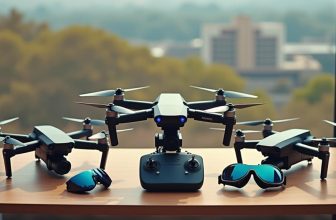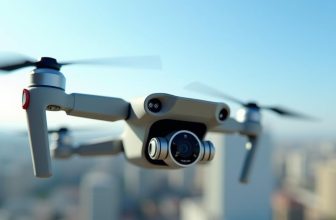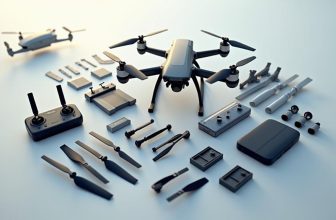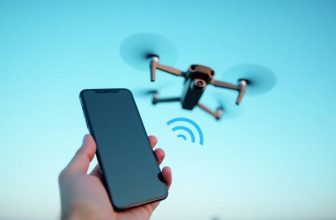
You're about to join the over 1 million drone enthusiasts in the US alone who've taken to the skies with FPV drone flying. As a beginner, you're likely eager to get started, but choosing the right equipment can be overwhelming. With so many options available, it's essential to set a budget and prioritize your needs. You'll want to consider the type of flying you'll be doing most often, from casual cruising to high-speed racing. But before you can take to the air, you'll need to navigate the complex world of FPV drone components – and that's just the beginning.
Contents
- 1 Key Takeaways
- 2 Choosing the Right Equipment
- 3 Understanding FPV Drone Components
- 4 Drone Safety Precautions
- 5 Pre-Flight Checklist Essentials
- 6 Basic Flight Controls and Modes
- 7 Mastering Flight Techniques
- 8 Common Obstacles and Solutions
- 9 Essential Maintenance and Repair
- 10 Advanced Features and Upgrades
- 11 Frequently Asked Questions
- 12 Conclusion
Key Takeaways
- Set a budget and prioritize features for a beginner-friendly FPV drone setup.
- Choose a durable drone frame and body that provides easy access to components.
- Select an FPV camera with suitable resolution, field of view, and low latency.
- Familiarize yourself with airspace regulations, safety guidelines, and pre-flight checks.
- Master basic flight controls and modes, such as Acro, Sport, and GPS modes.
Choosing the Right Equipment
When choosing the right equipment for FPV drone flying, you've got a multitude of options at your disposal.
As a beginner, it's essential to consider your budget and personal preferences to ensure you get the most out of your flying experience. Budget considerations will play a significant role in determining the type of equipment you can afford.
Set a budget and stick to it to avoid overspending on features you may not need.
Your personal preferences will also influence your equipment choices.
If you're looking for a more immersive experience, you may want to invest in a high-quality FPV headset with a wide field of view.
On the other hand, if you prioritize portability, a compact transmitter and drone combo might be the way to go.
Consider the type of flying you'll be doing most often and choose equipment that suits your needs.
Understanding FPV Drone Components
As you assemble your FPV drone, it's essential to understand the core components that make up this high-performance machine.
You'll be working with a drone frame and body, which provides the structural integrity to withstand crashes and harsh conditions.
The FPV camera systems and flight control boards complete the package, allowing you to capture stunning footage and execute precise maneuvers.
Drone Frame and Body
Building your FPV drone from scratch starts with the foundation: the drone frame and body. You'll want to choose a frame design that suits your flying style and the type of drone you're building.
Popular frame designs include the X, H, and quad configurations. When selecting a frame, consider factors such as weight, durability, and ease of assembly.
Body durability is also crucial, as it will protect your drone's components from crashes and impact. Look for frames made from high-quality materials like carbon fiber or aluminum, which offer excellent strength-to-weight ratios.
A well-designed body should also provide easy access to components, making maintenance and repair a breeze. You'll also want to consider the frame's size and shape, as this will affect the drone's aerodynamics and stability.
When assembling your drone, pay attention to the frame's tolerances and ensure that all components are securely attached.
A solid frame and body will provide a solid foundation for your FPV drone, allowing you to focus on fine-tuning your flying skills and enjoying the thrill of the flight.
FPV Camera Systems
You've got your drone frame and body sorted; now it's time to focus on the eyes of your FPV drone: the camera system. This is where you'll capture the immersive, first-person view that makes FPV flying so thrilling.
When choosing a camera, consider a few key factors: resolution, field of view, and latency. A higher resolution will provide a sharper image, while a wider field of view will give you a more expansive view of your surroundings.
However, a wider lens can also introduce lens distortion, which can make it harder to judge your drone's distance and orientation.
To combat this, you'll need to perform camera calibration, which involves adjusting the camera's settings to minimize distortion and ensure a clear, undistorted image. This process can be a bit tricky, but the payoff is well worth it – a well-calibrated camera will make your FPV experience feel more immersive and responsive.
Flight Control Boards
What makes your FPV drone react with lightning speed and precision to your every command? It's the brain of your drone – the flight control board (FCB).
This tiny board is responsible for interpreting your inputs and adjusting the drone's movements in real-time. As a beginner, understanding flight control boards will help you choose the right one for your drone.
When selecting a flight control board, consider the following:
- Processor speed and power: A faster processor means better performance and more precise control. Look for boards with at least a 32-bit processor and a decent clock speed.
- Sensor suite: A good FCB should have a comprehensive sensor suite, including accelerometers, gyroscopes, and magnetometers. This ensures stable and smooth flight.
- Compatibility and expansion options: Choose a board that's compatible with your drone's components and has expansion options for future upgrades.
When you've selected your FCB, don't forget to tune your flight controller.
This process can be complex, but it's essential for optimal performance.
Flight controller tuning involves adjusting parameters like PID gains, rates, and expo to match your flying style.
Drone Safety Precautions
As you prepare to take to the skies with your FPV drone, safety should always be at the forefront of your mind.
It's essential to understand the rules and regulations surrounding drone flight to avoid accidents and ensure a fun experience. Familiarize yourself with airspace regulations, such as no-fly zones and restricted areas, to prevent unwanted encounters with authorities.
You should also consider investing in drone insurance to protect yourself and others in case of accidents.
Drone insurance can cover damages to people, property, and the drone itself. Research different policies and choose one that suits your needs.
When flying, always maintain a safe distance from people, animals, and obstacles.
Be aware of your surroundings and keep an eye on the weather. Sudden changes in wind or precipitation can affect your drone's performance and stability.
Lastly, never fly over crowded areas or near airports, as this can pose a significant risk to people and aircraft.
Pre-Flight Checklist Essentials
Before taking to the skies, a methodical pre-flight checklist is crucial to ensure your FPV drone is airworthy and you're prepared for a safe, enjoyable flight.
As a beginner, it's essential to develop a pre-flight routine to ensure you don't miss any critical steps.
This routine is part of pilot preparation and helps you stay focused and calm.
Your pre-flight checklist should cover:
- *Drone inspection*: Check for any damage, loose screws, or worn-out parts. Verify that all propellers are securely attached and undamaged.
- *Battery check*: Ensure your drone and transmitter batteries are fully charged. Check the battery health and replace them if necessary.
- *System checks*: Turn on your drone, transmitter, and FPV goggles to ensure they're functioning correctly. Check for any firmware updates and calibrate your drone if needed.
Basic Flight Controls and Modes
You're now ready to master the basic flight controls and modes that will take your FPV drone flying skills to the next level.
As you grasp the transmitter, you'll notice the control sticks, each with distinct functions that control your drone's roll, pitch, yaw, and throttle.
Understanding these control stick functions and exploring the various flight mode options, such as Acro, Sport, and GPS modes, will be crucial in developing your muscle memory and precision flying techniques.
Control Stick Functions
Mastering control stick functions is crucial to unlocking the full potential of your FPV drone.
You'll need to understand how to use the sticks on your transmitter to control your drone's movements.
Proper stick calibration is essential to achieve smooth and precise flight.
If your sticks aren't calibrated correctly, you may experience erratic or unresponsive flight.
When it comes to throttle response, you'll want to make sure it's set up to your liking.
A well-tuned throttle response can make a huge difference in your flying experience.
Here are a few things to keep in mind when setting up your control stick functions:
- Imagine your drone hovering in front of you, and you make a gentle roll to the left by pushing the right stick to the left. The drone responds smoothly and predictably.
- You're flying at full speed, and you need to make a quick turn to avoid an obstacle. You push the stick hard to the right, and the drone responds instantly.
- You're trying to land your drone, and you need to make precise adjustments to the throttle and pitch. You make small, gentle movements on the sticks, and the drone responds accordingly.
Flight Mode Options
Now that you've fine-tuned your control stick functions for smooth and responsive flight, it's time to explore the various flight mode options that can elevate your FPV experience.
As a beginner, you'll likely start with Angle Mode, which stabilizes the drone's roll and pitch axes, making it easier to control. This mode is perfect for learning the basics of flight and building confidence.
As you progress, you'll want to switch to Acro Mode, which gives you full control over the drone's movements.
In Acro Mode, the drone will no longer stabilize its roll and pitch axes, allowing you to perform more advanced maneuvers like flips and rolls. This mode requires more skill and practice, but it's essential for taking your FPV flying to the next level.
When switching between modes, make sure to adjust your control stick functions accordingly. You may need to adjust the sensitivity and expo to suit the mode you're flying in.
Experiment with different modes and settings to find what works best for you and your flying style.
Mastering Flight Techniques
As you progress from casual FPV flying to more advanced maneuvers, your skills will be put to the test by complex flight techniques that demand precision and control.
Mastering these techniques takes time and practice, but it's an essential step in taking your flying to the next level.
To achieve smooth transitions between maneuvers, focus on maintaining a consistent speed and throttle input.
This will help you flow seamlessly from one trick to the next. Some aerodynamic tricks to try include:
- Tailslides: Slide your drone backwards while maintaining a steady altitude and yaw.
- Immelmann turns: Perform a half-loop and then immediately reverse direction.
- Split-S maneuvers: Dive down and then rapidly reverse direction, climbing back up to your starting altitude.
As you practice these techniques, pay close attention to your drone's orientation and position in the air.
Use your FPV feed to make adjustments on the fly and fine-tune your skills.
With time and patience, you'll be able to execute these complex maneuvers with ease and precision.
Common Obstacles and Solutions
During your FPV flying journey, you'll inevitably encounter obstacles that'll put your skills to the test.
One of the most common challenges you'll face is Wind Interference. Wind can drastically affect your drone's stability and control, making it difficult to navigate.
To counter this, you'll need to adjust your flying style and make use of your drone's wind compensation features. This may involve reducing your speed, increasing your throttle, and making smooth, gentle turns.
Another significant obstacle you may encounter is Pilot Anxiety.
As you begin to push your flying skills to new heights, it's natural to feel a sense of unease or nervousness. This anxiety can cause you to make mistakes and lose control of your drone.
To overcome this, focus on your breathing and try to relax. Take a break if you need to, and remember that practice makes perfect. Visualize yourself successfully navigating challenging scenarios, and remind yourself of your past achievements.
Essential Maintenance and Repair
Within the fast-paced world of FPV drone flying, you're constantly pushing your equipment to its limits, and that means regular maintenance is crucial to prevent costly repairs down the line.
By staying on top of maintenance, you'll ensure your drone remains airworthy and continues to deliver the thrilling experience you crave.
- Inspect your motors regularly for signs of wear, such as excessive vibration or unusual noises, and replace them as needed to prevent motor failure.
- Balance your propellers to ensure smooth, efficient flight – an out-of-balance prop can cause your drone to wobble or even crash.
- Clean your drone's airframe and electronics after each flight to remove dirt, dust, and debris that can cause overheating or electrical issues.
Regular maintenance also involves checking for loose screws, damaged wires, and proper ESC calibration.
By performing these tasks, you'll extend the lifespan of your drone, prevent costly repairs, and enjoy a more reliable flying experience.
Stay on top of maintenance, and you'll be rewarded with a drone that continues to deliver the excitement and thrill of FPV flying.
Advanced Features and Upgrades
Boost your FPV drone's performance and take your flying experience to the next level by exploring advanced features and upgrades.
Once you've mastered the basics, it's time to dive into the world of customizations.
Consider upgrading to a high-performance ESC, motor, and propeller combination to increase your drone's speed and agility.
This will allow you to tackle challenging racing gates and complex aerial maneuvers with ease.
Custom rigs are another exciting area to explore.
You can design and build your own FPV drone from scratch, choosing components that cater to your specific flying style and preferences.
This level of customization allows you to optimize your drone's performance for specific applications, such as racing or aerial photography.
When building a custom rig, pay close attention to the compatibility and synergy between components to ensure seamless performance.
With advanced features and upgrades, you'll be able to push your FPV skills to new heights and enjoy a more immersive and exhilarating flying experience.
Experiment with different configurations to find the perfect balance of performance and style.
Frequently Asked Questions
Can FPV Drones Fly in Rainy or Wet Conditions?
You're flying high and wondering if your drone can handle rainy weather. While most drones aren't waterproof, some models are designed to withstand wet conditions – look for rugged, waterproof drones to keep flying in the rain.
Do I Need a Drone License to Fly Fpv?
Are you ready to take to the skies with your FPV drone? You'll need to check drone regulations in your area, as flight restrictions vary – a license might be required for commercial or high-altitude flights.
Can I Use FPV Goggles With Prescription Glasses?
You can definitely use FPV goggles with prescription glasses by opting for goggle compatibility or lens modification. Many brands offer prescription lenses or adapters, so you can still enjoy immersive FPV experiences with corrected vision.
How Do I Update My FPV Drone's Firmware?
Updating your drone's firmware is like upgrading a high-performance sports car – it requires precision. You'll need to check the manufacturer's website for the latest firmware versions and follow their update protocols carefully to avoid errors.
Can FPV Drones Fly at Night With Extra Lighting?
You're eager to take your FPV drone flying to the next level. Yes, with night vision capabilities and strategically installed LED lights, you can navigate and capture stunning footage in low-light conditions with precision.
Conclusion
You've just embarked on an epic adventure, and the open skies are calling your name. Grab your trusty quill and sign on the dotted line – you're in this for the long haul. As you soar through the world of FPV drone flying, remember to stay curious, keep learning, and never stop pushing the limits. With every flight, you'll unlock new thrills and master the skills that'll make you a true aerial maestro.






